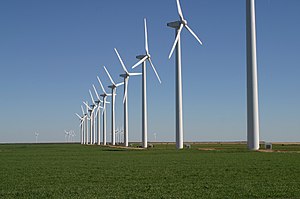 Image via Wikipedia
Image via WikipediaAstrum Energy (Pty) Ltd, a company engaged in providing turnkey solutions for sustainable energy projects, plans to build a ZAR1,200m ($151.46m) onshore wind power project on farmland north-east of Empangeni, Northern KwaZulu-Natal, South Africa. The total installed capacity of the project will be 80 MW, comprising about 20 to 30 wind turbines.
Each turbine will generate about two to three megawatt of electricity. The investment per MW will be approximately $1.89m. The electricity generated from the project will be sufficient to power about 1,800 households. The company is in the process of preparing an environmental impact assessment (EIA) for the project. The construction of the project is expected to complete within 18 months from the date of construction.
Florian Kroeber of Astrum Energy, said, “Initial testing had started a year ago on an existing cell phone mast. We have preliminary agreements in place with Eskom. Before the agreements are finalized, we have to prove the viability of the project, conduct a full environmental impact assessment (EIA) and have several other permits in place. The only issue raised at the meeting was about business opportunities by local businesses. A second meeting will be held in about five months time. With an 80 MW rating, this could see Empangeni become a net exporter of electricity feeding into the existing Eskom grid. The first is the grid connection to high voltage lines, something the Richards Bay and Empangeni area have plenty of. Second is wind resource, which has proven to be sufficient to make the development viable. Land availability and infrastructure is another consideration, as is the chosen site’s proximity to the port of Richards Bay. The only land required is the footprint area for the base of the actual wind turbine, which is about 200 sq.m. As the chosen site is under sugar cane, the impact on agricultural activities would be minimal and in fact would augment the landowners’ income. The site’s close location to Richards Bay means that the transport cost of bringing the large, fully imported components from the harbor to the site would not be too high. Considering that this is an infrastructure investment of around R1.2 billion, three years is a short period for planning. The total height of the wind turbines is up to 160 meter, which is quite high when one considers that the peak of Durban’s Moses Mabhida Stadium arch is around 106 meter. However, the visual impact will be minimal as the towers and the blades are thin and would be painted white to blend into the background. Noise impact would also be minimal as the standard set-back line of such wind turbines from residential units is 300m. Beyond 200-250m you won’t hear them. The wind turbines kick in at wind speeds of 2.5 meter per second and generation flattens out at 11m/s. It makes no difference to the generation if there is stronger wind. The company had plans for social investment by allocating 10% of the wind farm’s shares to a community trust that would support projects in the area such as hospitals, libraries and schools. Further benefits for the region as a whole would be that projects that have been put on hold because of insufficient power supply to the area could now go ahead, creating far more secondary employment than the wind farm itself.”











